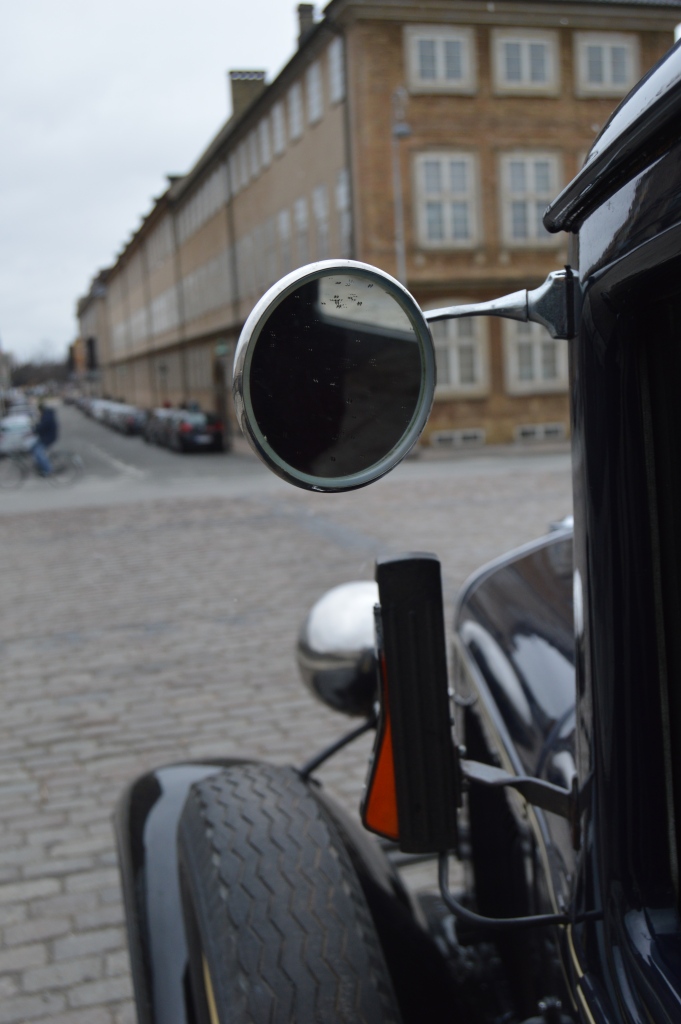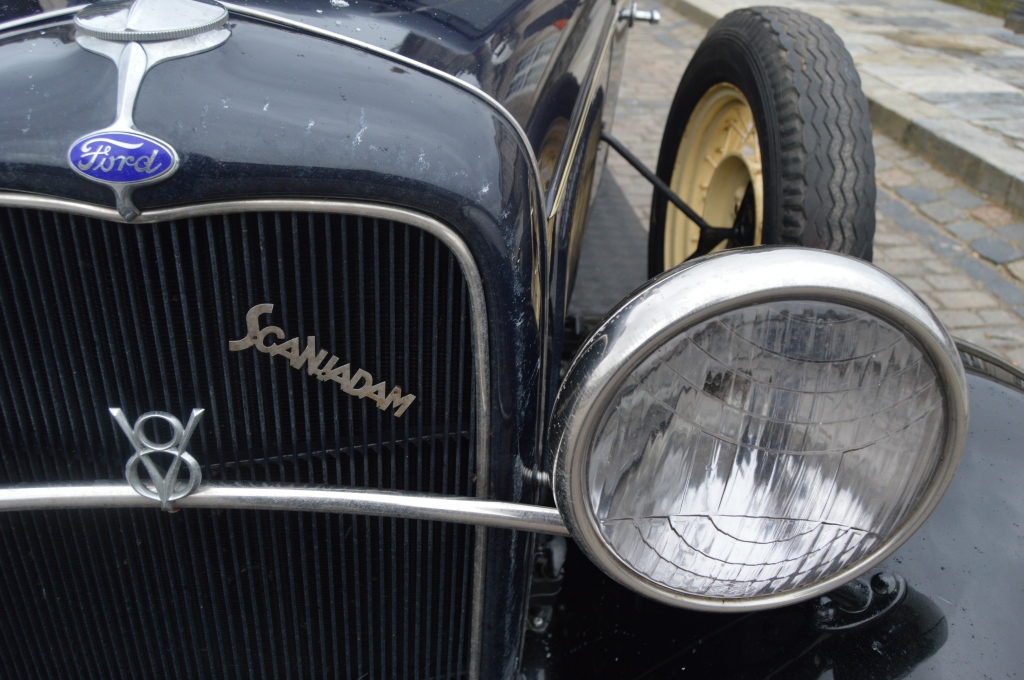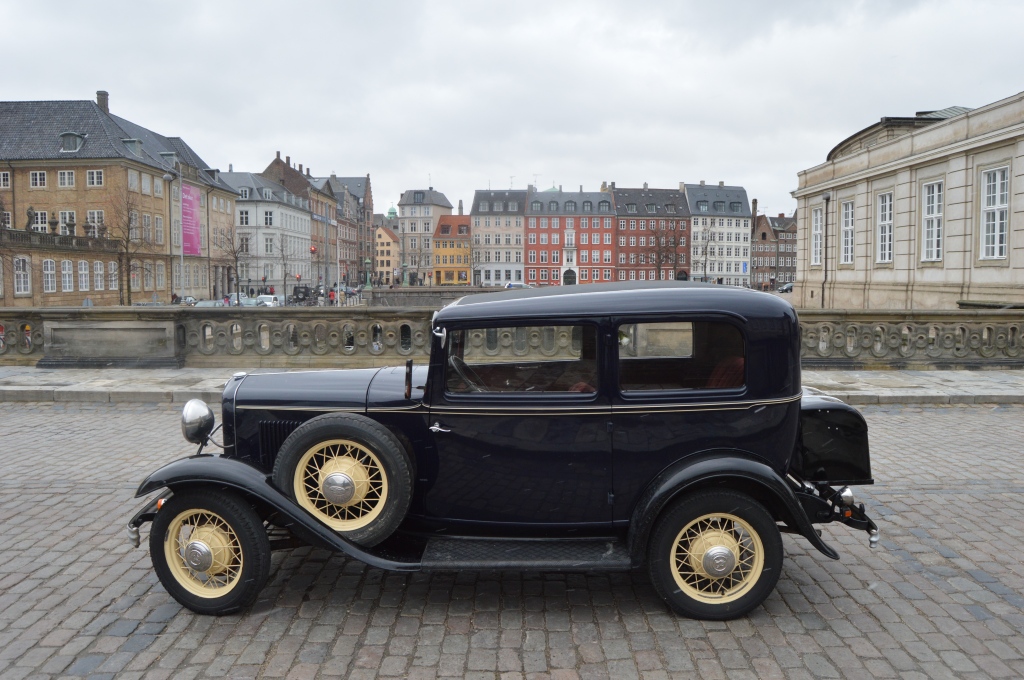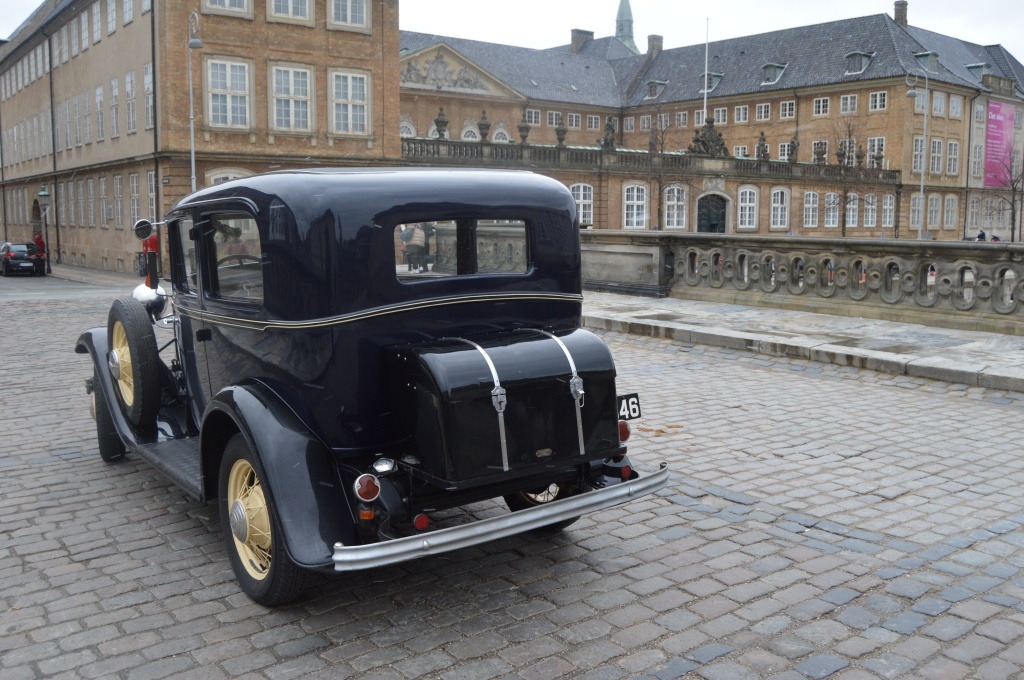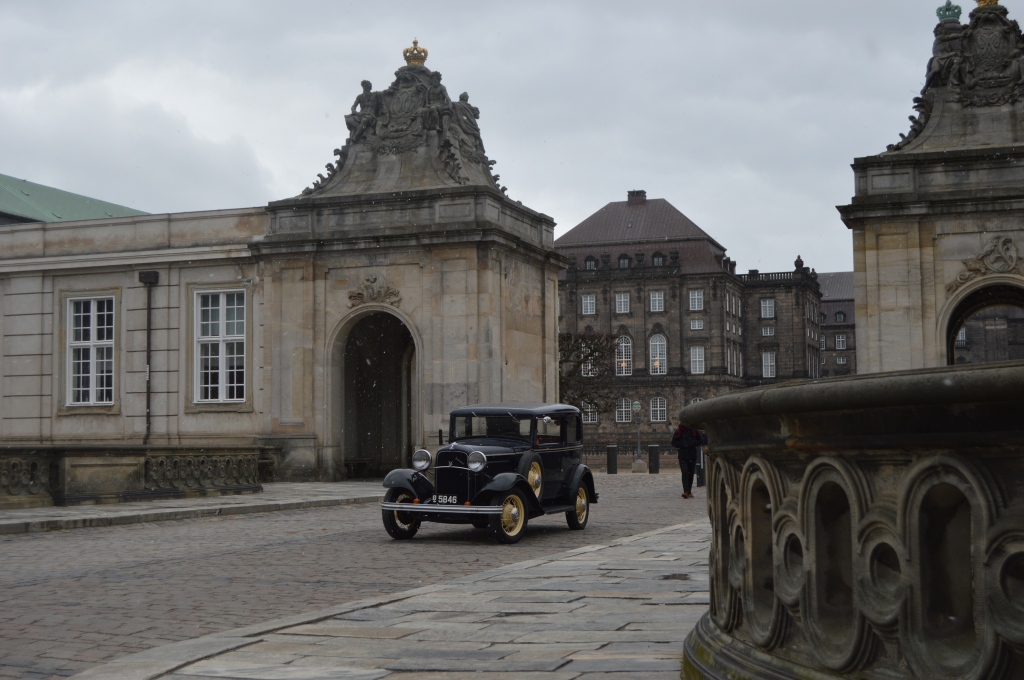At the time this picture was taken, this car was being used as a wedding car for a couple who had chosen an exceptionally dramatic (and dramatically cold) backdrop for some wedding photos: Christiansborg Slot in Copenhagen, Denmark. Their photos, and mine as well, incidentally, were graced with some snow too, which was a nice surprise. However unimaginative it might be, that is probably the best way I can describe my trip to Copenhagen: a nice surprise. Faced with bigger, edgier and richer cities like Amsterdam, Berlin and even Brussels, Copenhagen often gets lost in the fray. Much like, in case you couldn’t see where that clunky metaphor was headed, this old geezer. This is a 1932 Ford Model 18 Tudor Sedan.
The Ford Model 18 was Ford’s answer to cars like the Chevrolet AE Independence, but that doesn’t really tell the whole story. The Model 18 wasn’t just a response to Chevy; it was a response to the Great Depression. Henry Ford came up with a not-at-all influential car called the Model T in 1908, but by the mid 1920s, consumers were starting to grow tired of this earth-shattering invention. Chevrolet actually outsold Ford in 1927 and 1928, which stirred in Henry a sense of vengeance. He would have the sales crown again, or so help him, he would dress up as a flapper girl and dance in a speakeasy, or whatever it was people did in the 1920s. Further complicating the issue was the Great Depression, which didn’t seem to affect golden-boy Chevrolet very much, while Ford floundered. He needed a car- something radical. The company toyed with the idea of an engine in the shape of an X, which didn’t work out, but is nonetheless interesting in an alternate-history sort of way. It was eventually settled that the new car would have a V8, with Ford himself giving the reason that “we’re going from a four to an eight because Chevrolet is going to a six.” All this was a bit begrudging on Henry’s part too, because he, at heart, was a four-cylinder kind of guy, saying: “I’ve got no use for a motor that has more spark plugs than a cow has teats.”
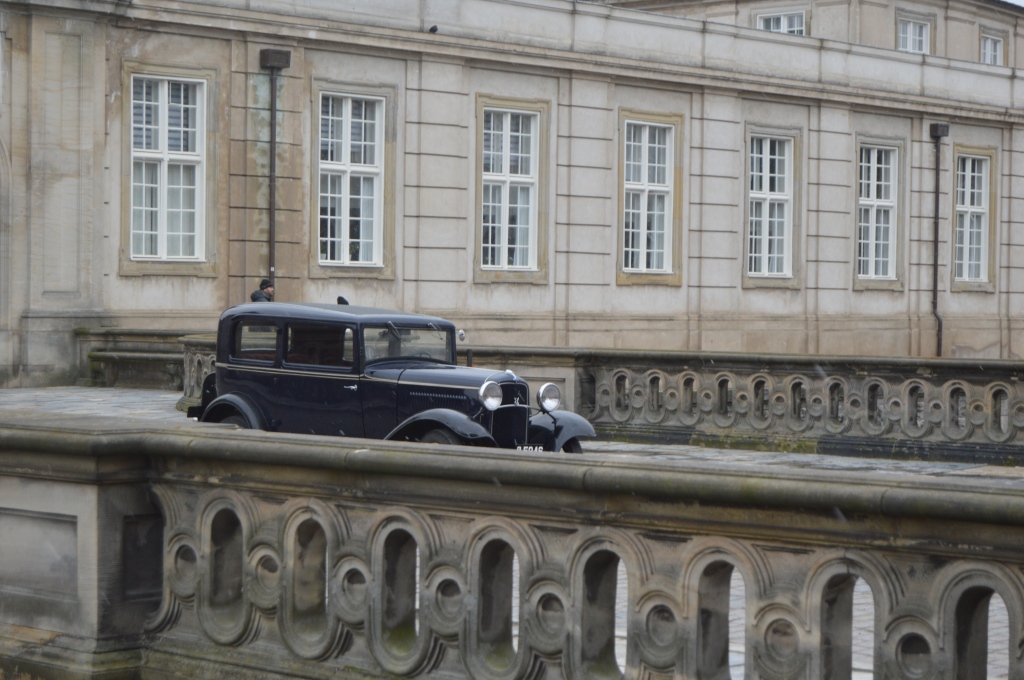
Now, it’s important to note at this point that V8s were very expensive to manufacture, with only brands with names like Cadillac, LaSalle, and Oakland featuring them. With his plan to sell the new car within the relatively attainable $500 to $600 range, there was a healthy dose of skepticism in the air at the Ford Motor Company. But Henry Ford, ever the quote machine, fired back, saying that “anything that can be drawn can be cast.” Say what you will, the man had gumption. Anyway, Ford’s boss, a guy named Lawrence Sheldrick, commissioned engineer Arnold Soth to design this new V8 that Henry wanted so much. Problem was, Ford didn’t really like the way the project was going, so he commissioned his own engineers to design a completely different V8 for the car, in Thomas Edison’s old workshop no less (they were later moved from Fort Myers to Dearborn, Michigan). Now, while all this was happening, the company had the Model A, a four-cylinder car, running about, just to tide the company over in the transition between the Model T and the forthcoming Model 18. We actually had the truck version of the Model A, the Model AA, on Forgotten Metal a very long time ago. That truck actually ties this as the oldest car we’ve ever had on the blog! Isn’t that exciting?
The problem with the Model A was that, to put it lightly, it was a little unloved by the car-buying public. Why buy a measly, 50 horsepower Ford when you could walk down the street and pick up a brand new Plymouth with 65 manly, rip-snorting horses? Which is exactly why this V8 project was so important. When it was released in 1932, people went crazy for the Ford V8. Within days of its release to the public, Ford had over 200,000 orders for the car. Which was great. Henry had commissioned his son, Edsel Ford, to design the body of the new car, which to many looked like the much more ritzy Lincoln that had just been released. Which was also great. The problem, however, came when the company was faced with filling all those orders. Further complicating the whole ordeal was the pesky issue of reliability, “pesky,” in this context, meaning “ruinous.” Nearly every mechanical part of the Model 18 had some sort of outstanding problem. Pistons failed, bearings failed, engine blocks cracked, camshafts, pushrods and valves all needed to be replaced. The car had some pretty serious teething troubles, prompting many to call it the first car to have its developmental engineering done by the public.
We’ve been talking about history for awhile, and I’m starting to feel dusty. Let’s talk about some specifications, shall we? The V8 in this car, called the “Flathead” V8, produced 65 horsepower and had 221 cubic inches of displacement. This made for a top speed of 80 miles per hour, which, like the movie Nightcrawler, was not bad at all. It also has a three-speed manual transmission. Zero to sixty was clocked by one magazine at 16.8 seconds, which is actually a bit faster than some more modern cars.
Okay, story time: the year was 1934, the place was Chicago, Illinois. Known gangster John Dillinger was on the lam from the coppers, having escaped a gunfight with police in Hastings, Minnesota. Dillinger’s fellow gangster, John Hamilton, had just died of some lingering bullet wounds, so it was high time the crafty criminal found himself a new set of wheels. Dillinger’s girlfriend, Billie Frechette, was due to stand trial in a few days under charges of harboring Dillinger in her apartment in Minneapolis, and Johnny wanted real bad to be there for her. You know, for moral support, something any good boyfriend would provide, really. Dillinger stole a brand new Ford Model 18 for the trip, not totally unlike this one. After arriving Minneapolis, where Frechette pleaded not guilty, Dillinger wrote Henry Ford himself a letter, thanking him for building such a fast and sturdy automobile. Dillinger was gunned down outside a movie theater in Chicago six weeks later, so unfortunately the legendary gangster didn’t have very much time to enjoy his new car. Now, in the interest of full disclosure, this story is widely considered to be a hoax dreamed up by Ford’s advertising department (which isn’t totally untrue), but a full investigation was conducted a few years ago, which found much of the tale to be legitimate. Still, regardless of the murky specifics, it’s a good story worth telling, and if you’ve been here before, then you know I love a good story.
You really must spend a couple days in Copenhagen if you get the chance. Lovely old castles and palaces, boats for (nautical) miles, and delicious smorrebrod– what more could a single traveler ask for? Relaxed marijuana laws maybe? Well, if you’re into that sort of thing. And one of the most peculiar things? Copenhagen isn’t really on the top of anyone’s “destinations” lists. Maybe I’m looking at this in the wrong way, though. People from here have a word, jante, which discourages attention seeking of any kind. Perhaps the reason Copenhagen is so brilliant is because no one ever thinks of it. It’s untouched, unsullied and refreshingly un-touristy. Which is ironically delightful because I was, effectively, a tourist. Which brings us to the Model 18. Everyone knows about the Ford Model T. Even people who don’t know the first thing about cars could probably pick a Model T out of a parking lot. Many even (mistakenly) call it the world’s first car. But the Model 18? Well, that’s a different story. It was the third car Ford ever produced, and the third album is always a difficult one to get excited about. But perhaps that’s the point. The Model 18 was a great car, especially once the company worked out its early kinks. An overlooked gem, and one, you get the sense, that is happy to stay that way.
Additional Thoughts:
- Racing car driver Eddie Pullen, under the direction of Pennzoil, drove a Model 18 33,301 miles across the Mohave Desert, averaging 41 miles per hour and 19.64 miles to the gallon, all in 110-plus degree heat.
- Model 18’s can be distinguished from their four-cylinder counterparts, the Model B’s, by the iconic “V8” emblems mounted to the front grille and on the hubcaps.
- The V8 in this car, in some form or another, continued to power various Ford vehicles for another 21 years.
- About 223,000 of these cars were built in the US and overseas (including in a factory in Copenhagen!). This makes it, relatively speaking, one of the more desirable cars from this era.
- The Model 18 (and its counterpart, the Model B) came in over 30 different bodystyles altogether, ranging from roadsters to work trucks.

